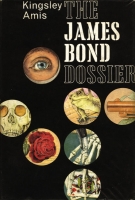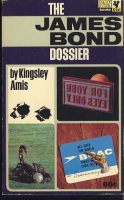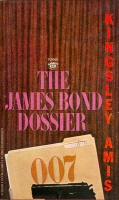INTRODUCTION
Prior to the death of Ian Fleming, Kingsley Amis, a novelist, poet, critic and teacher set out to write a modestly-sized essay of about 5,000 words that critically analyzed Ian Fleming’s James Bond works. This modestly-sized essay ballooned into a full length non-fiction book and was finally released on May 27, 1965, one month after the release of Fleming’s posthumous James Bond novel, The Man with the Golden Gun, and one year prior to the release of the short story collection Octopussy and The Living Daylights (though it does refer to “The Property of a Lady”). The James Bond Dossier was the second book published, following O.F. Snelling’s 007 James Bond: A Report (1964), to delve into the heart of Fleming’s stories and chronicle the adventures, the characters, and all other things, Bond. Later in 1965, Amis published his second non-fiction James Bond book, The Book of Bond or, Every Man His Own 007 a tongue-in-cheek manual for perspective secret agents on how to live and do the job as James Bond 007 would. This book was written under the pseudonym of Lt.-Col William (“Bill”) Tanner, M’s chief of staff.
These books are primary reading material for all James Bond fans for the simple fact that Kingsley Amis, himself a big Bond fan, went on to write the first continuation novel, Colonel Sun, in 1968 under the pseudonym Robert Markham. Raymond Benson later followed in Amis’ footsteps by writing the very popular The James Bond Bedside Companion, an in depth look into the literary and cinematic adventures of James Bond including the works of Amis and John Gardner before being offered the opportunity by Glidrose Publications to write his first novel Zero Minus Ten.
INTEL
Chapter Listing
ix. Preface
1. The Man Who Is Only A Silhouette
2. Sit Down, 007
3. Going Slowly To Pieces
4. No Woman Had Ever Held This Man
5. Beautiful Firm Breasts
6. A Glint of Red
7. Damnably Clear Gray Eyes
8. Warm Dry Handshakes
9. We May Be Slow, But . . .
10. Elegant Scene
11. The Shertel-Sachsenberg System
12. Y*B**NNA MAT!
13. Upas-Tree
14. The Beautiful Red And Black Fish
Appendix A Science Fiction
Appendix B Literature and Escape
Appendix C “Sadism”
JAMES BOND
As the book opens Amis defines what James Bond really is, a secret agent – not a spy, for a spy is someone “who steals or buys or smuggles the secrets of foreign powers,” which Bond did only on one occasion in From Russia with Love, but even then as Amis points out, it was forced upon him by the Soviets. Additionally Bond can also be defined as a counterspy or “one who operates against the agents of unfriendly powers.” Amis argues that Bond is mistaken as a spy for the sheer fact that it’s far simpler to label him as such and because titles such as “The Medium-Grade Civil Servant Who Loved Me” just doesn’t sound as good.
As Amis continues he constantly compares James Bond to other fictional detectives and secret agents such as John Steed, Mike Hammer, and Bulldog Drummond, especially when questioning Bond’s apparent trouble and motives with taking the lives of England’s enemies. As fans recall, Bond has a major meltdown in the opening chapter of Goldfinger where he questions the action he took in killing a capungo (a Mexican bandit) the day before. In “For Your Eyes Only” though, Bond doesn’t really even really hesitate to take on a matter of personal vengeance for M in killing Von Hammerstein even though it has nothing to do with England and its defense or well-being. He just accepts the job claiming that Von Hammerstein deserves to die, probably out of a sense of duty and loyalty to M. In Goldfinger Fleming writes:
It was part of his profession to kill people. He had never liked doing it and when he had to kill he did it as well as he knew how and forgot about it. As a secret agent who held the rare Double-O prefix — the licence to kill in the Secret Service — it was his duty to be as cool about death as a surgeon. If it happened, it happened. Regret was unprofessional — worse, it was a death-watch beetle in the soul. – Goldfinger
Compare this to Mike Hammer:
I lived to kill so that others could live. I lived to kill because my soul was a hardened thing that revelled in the thought of taking the blood of the bastards who made murder their business. . . .I was the evil that opposed other evil, leaving the good and the meek in the middle to live and inherit the earth. – One Lonely Night (Mickey Spillane)
Amis finally concludes that, at least in fiction, to be a secret agent a man has no choice but to be a hypocrite.
Amis eventually covers all the basics of James Bond; his habits: smoking, drinking, and womanizing; his attitude and emotional state especially after his late wife was gunned down practically in his arms in the finale of On Her Majesty’s Secret Service. He continues on talking about James Bond’s love interests from Vesper Lynd to Mary Goodnight, whom the latter Amis feels hardly qualifies, the various Bond villains from Le Chiffre to Scaramanga, though again the latter Amis feels hardly qualifies. He also discusses M and most if not all of Bond’s allies.
FLEMING
Kingsley Amis gives Ian Fleming the full literary critique usually with tongue firmly in cheek. At one point he charges Fleming with being somewhat of a snob or of “glamour-susceptibility”. He also points out how formulaic Fleming’s adventures can be, suggesting that James Bond is secretly a glutton for punishment for in almost every adventure he is captured and tortured and that Bond may be doing this deliberately. For that matter it’s also possible that Bond isn’t much of a womanizer at all, for he can’t really be held responsible when the young pretty girl with beautiful firm breasts appears – can he? Amis writes:
Its most noticable feature is that so to speak, the given girl appears in the first place. After reading a couple of Bonds we know that at some stage in any one of them, as ally or as confederate of the enemy (but never as public librarian or best-friend-in-the-Navy’s-little-sister – always as novel and as isolated a figure as possible), wandering about on a Caribbean beach or heralded on the road by the sexy boom of twin exhausts, she is going to turn up.
‘Never’ went away circa 1982 when James Bond slept with his best friend’s daughter. For shame John Gardner, for shame.
Amis also sings high praises of Fleming. He coins the term “The Fleming Effect” in this book, which essentially means that his gift was the ability to write with such an imagination and such an air of authority about the improbable, but perhaps not completely the impossible, that the reader believes certain aspects to be unquestionably true. Probably the best example of this is the sequence in Goldfinger where Oddjob gets sucked out of a window at 35,000 feet. In the film this happened to Auric Goldfinger after he shot a round from his revolver through a window. This supposed myth that someone could be sucked out due to explosive decompression was so firmly set in people’s minds (see other popular films such as Airport where this is discussed and Fight Club in which you see passengers on board an airliner get sucked out after an explosion) that it finally was put to the test in 2003 during a segment of the the popular show Mythbusters. The show runners failed to create any sort of sudden decompression that would have enough pull to suck a man through a window. In fact using explosives they couldn’t even get the dummy sitting near the window to fall out of the cabin. According to Amis, the Fleming Effect can be observed the most in Thunderball.
The James Bond Dossier is full of great information about Fleming and James Bond. It goes into more depth about Fleming and sadism, science fiction, and even has a quick reference section in the back where Amis remarks on all the books (this is done again, even better, in Benson’s The James Bond Bedside Companion). For this section, notably Amis lays down probably his harshest criticism of The Man with the Golden Gun, which he calls “very thin” and accuses it of being reworks of Diamonds Are Forever and Goldfinger. After The Man with the Golden Gun was released Amis wrote in the New Statesman calling it “a sadly empty tale, empty of the interests and effects that for better or worse, Ian Fleming made his own.” Most fans and critics seem to agree.




